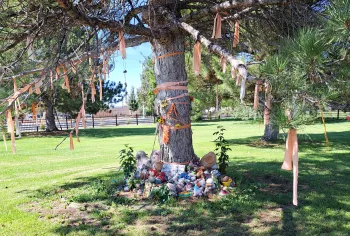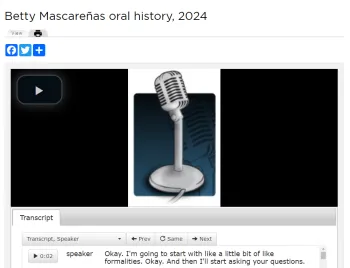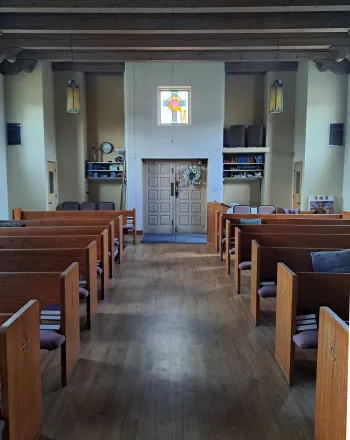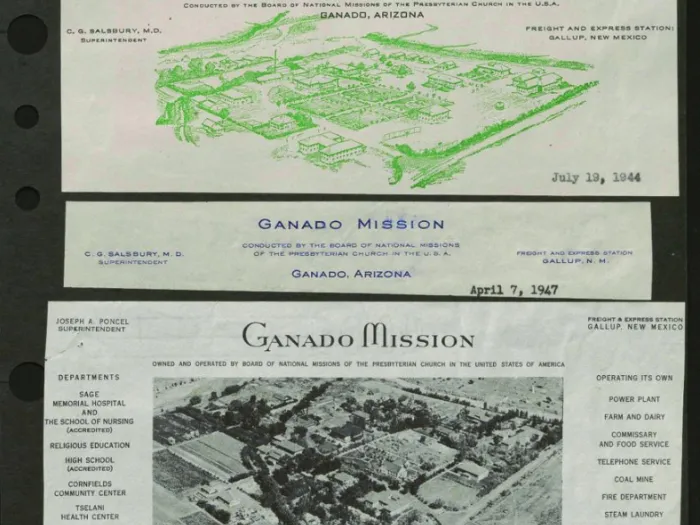Take Carlisle Boulevard to Indian School Road. At 12th and Indian School, where there's now a McDonalds, two convenience stores, and a hotel, look around. The Presbyterian-founded Albuquerque Indian School (AIS) was here. Walk north and west to Menaul Street to a little park. Now known as the AIS burial ground, its use was unacknowledged until city workers installing sprinklers in 1973 discovered the remains of children.
These names on the land in New Mexico return inexorably to the national project to "civilize the Indian," initiated at the federal level in Carlisle Pennsylvania, with the advice and close observation of Sheldon Jackson, whose Industrial School at Sitka Alaska was the primary influence for Carlisle.

People's memorial for the Albuquerque Indian School burial ground, including Land Back sign.
I was back in New Mexico during the third week of July, my first visit since 2018, at the invitation of friends of PHS, hoping to learn more about the works of Presbyterians in the Land of Enchantment. I encountered complex legacies of war, overland white settlement, ethnic cleansing, and economic oppression, all born witness to by Presbyterians--among them, members of the 19 Pueblo tribes in New Mexico, descendants of Spanish settlers from as early as the 16th century, and white English-speaking Anglos who settled here in the 19th century.
On Friday, July 19, alongside Rev. Madeline Hart-Andersen, I spoke with Libby Naranjo, a teacher at the Presbyterian-run school for Hispano children, Allison-James in Santa Fe. Libby was a product of the Presbyterian-affiliated Wilson College in Chambersburg, PA, and had done one summer at the Ganado Mission in Arizona, before her Board of National Missions appointment to New Mexico. She ended up marrying Gaspar Naranjo, part of a Northern New Mexico family who were the first converts to Presbyterianism there.
On Saturday, I spoke with Betty Mascareñas, who was a nurse at the Presbyterian mission hospital at Embudo, New Mexico, serving alongside Edith Millican and others. Her first husband Tomas Asencio was a Chicano rights activist and a founder of La Academia por la Nueva Raza. Betty and Tomas's house served as a gathering place for young activists, community organizers, and Volunteers in Service to America (VISTA) program volunteers, and Betty kept a pot of beans and a pot of chili at the ready. Among La Academia's works was a compilation of recordings with Hispano and Pueblo elders/ancienos helping to document Northern New Mexican folkways. Older folks in Dixon looked down on the young activists and their habits, calling them marijuanos.

Listen to Betty's oral history in Pearl.
One of the young people in this ambit was Alberto Cordova, a second generation Presbyterian from Penasco, and McCormick Theological Seminary student. Cordova went to McCormick during the American War in Vietnam, and became further radicalized by the nascent Brown Power struggles among Puerto Rican and other Latino communities in Chicago. He described much of his time in the movements as chaplaincy, alluding to the spiritual burnout political activists face. Alberto would be ordained in 1975 when "the revolution was over" and would go on to serve as a chaplain in the US Navy, Army, and Air Force.
Back in Albuquerque on Sunday I sat down with local historian Joe Sabatini to learn more about the Albuquerque Indian School gravesite. As far as we know, the site was likely in use from 1890 to 1932. In Sabatini's account the grave site's creation was the product of a perplex set of issues. AIS took in children from across what's now the Southwestern United States--Zuni, Apache, and Navajo children among them. Between about 1880 and 1910, New Mexico gained prominence among wealthy Anglos from the East for its dry, healthful air. After moving to the region, they started tuberculosis sanitariums including the present-day Presbyterian Health System, the descendant of one Presbyterian TB hospital in Albuquerque. Indigenous people, some of whom worked in the laundries and kitchens of these sanitariums, had largely not been exposed to tuberculosis, and it swept through their communities. So children's deaths at AIS were possibly from flu or TB. Transporting children to their families rapidly would have had to have been done by wagon train during this period, leading to desecration of the body. Local burial was the least bad option.
Much of this is speculation and interpretation, because many official records of AIS were lost, first in a basement flood in 1980, and then, after the school closed in 1981, in a series of fires.
Upon rediscovery of the burials in 1973, the City of Albuquerque placed a bronze marker at the site. This was stolen in 2019. Following protests in 2020, where residents found in the site an analog for the murdered indigenous children at Canadian boarding schools, the City promised to preserve the site and commemorate the children. That process, involving Parks and Recreation, the Office of Equity and Inclusivity, the 23 federally recognized tribes, and others, is ongoing.
Rev. Hart Andersen and I also spent time at First Presbyterian Church, Santa Fe with church archivist and long-time PHS patron Betty Kersting, who showed us around her operation, and offered for the PHS library holdings an 1880s volume of the Iglesia nacional presbiteriana de México house organ El Faro.

Interior of Westminster Presbyterian Church, Santa Fe, NM.
Today's Westminster has its roots in the old First. In 1893, the Hispano members of First moved to organize their own congregation, becoming IP Segunda. For their early life they shared space at First Presbyterian Church. In the 1950s the church bought its own plot of land, with support from the Board of National Missions.
Congregants carved all the woodwork, built stucco walls, and finished the interior. Like many Northern New Mexico churches its style is in part a reaction to Catholic ornament. The space has no storytelling stained glass. It is warm, austere, Reformed.
We're grateful to our partners in ministry and all our friends in Santa Fe Presbytery. Stay tuned for first-hand accounts of Presbyterian life in New Mexico, as our incoming oral histories get published.
You may freely reuse and distribute this article in its entirety for non-commercial purposes in any medium. Please include author attribution, photography credits, and a link to the original article. This work is licensed under a Creative Commons Attribution-NonCommercial-NoDeratives 4.0 International License.




